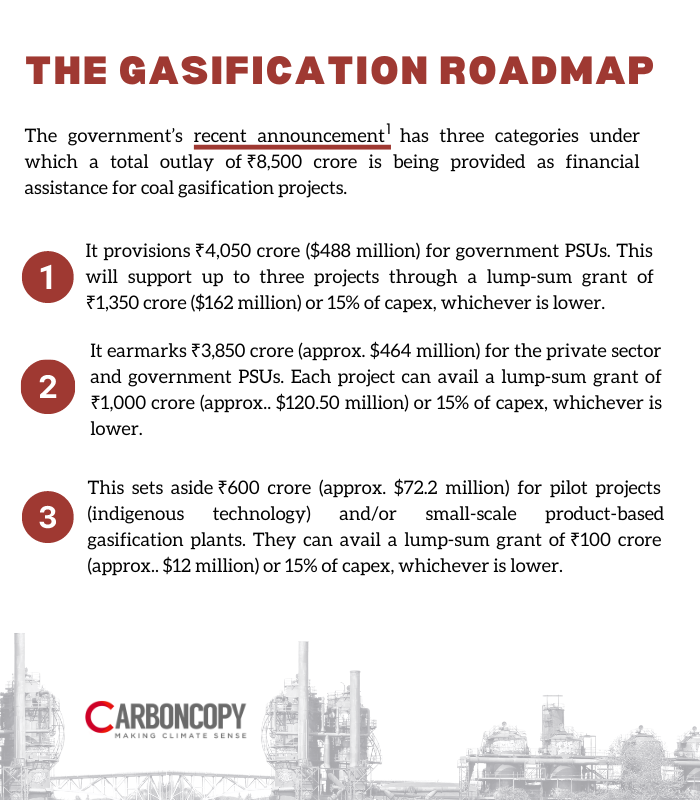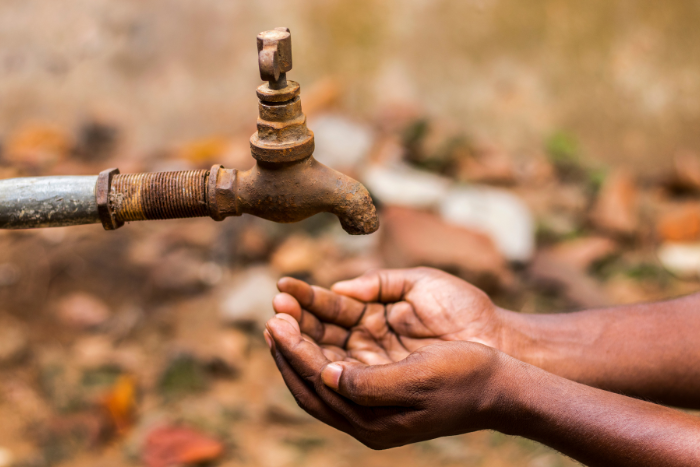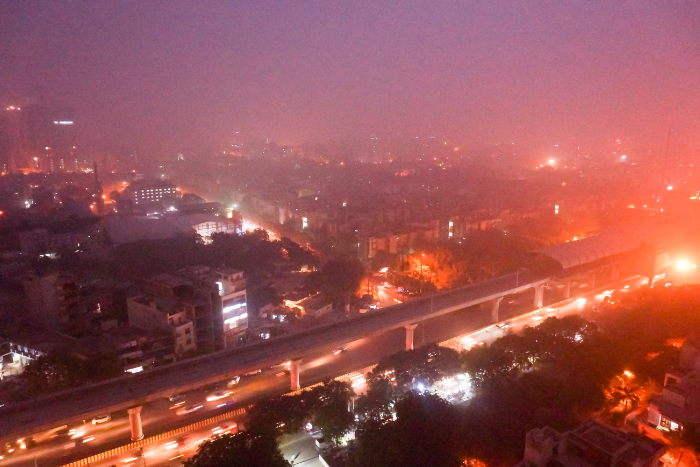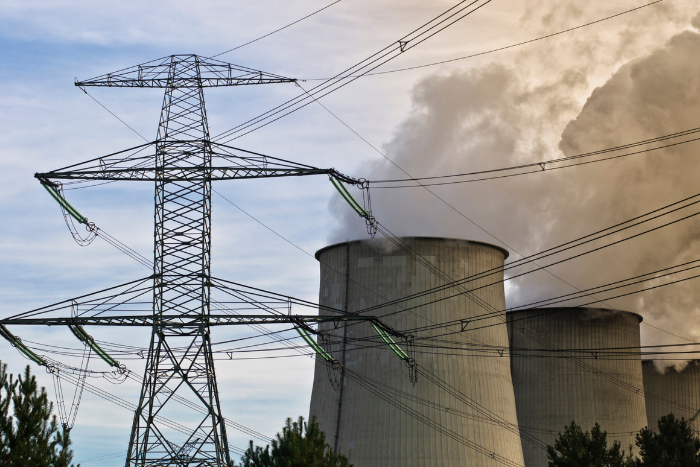
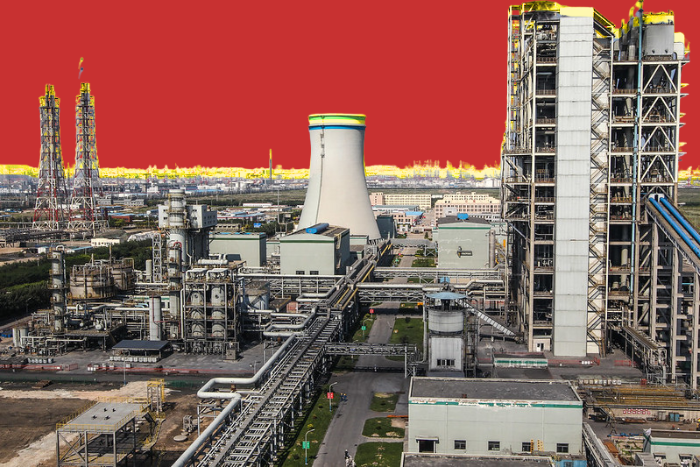

The country has abundant reserves of coal to achieve its 100 MT by 2030 gasification target, but issues such as poor quality coal, questions regarding price competitiveness and lack of effective carbon capture and utilisation technologies need to be addressed in order to make it sustainable. Read more
While the coal gasification process is energy- and water-intensive and produces high CO2 emissions, India is already providing financial assistance and rebate to promote these projects. Photo: (Edited) Tianjin Integrated Gasification Combined Cycle Power Plant Project in the People's Republic of China by the Asian Development Bank on Flickr
India’s coal gasification plans: More glitter than gold?
The country has abundant reserves of coal to achieve its 100 MT by 2030 gasification target, but issues such as poor quality coal, questions regarding price competitiveness and lack of effective carbon capture and utilisation technologies need to be addressed in order to make it sustainable
In recent years, India has embarked on a massive coal gasification push. The reasons for this are simple— India has pledged to combat the climate crisis by “transitioning away” from fossil fuel and reducing its carbon emission intensity. India also intends to achieve the net-zero by 2070. But at the same time, it faces the prospect of leaving its abundant supply of cheap domestic coal unutilised. In such a scenario, India views coal gasification as a viable “cleaner option compared to burning of coal” to reduce the emissions and cut its rising import bills of natural gas and energy fuels like methanol, ethanol, and ammonia.
Planning for gasification of coal and lignite has gained momentum over the past decade. Two years ago, in September 2021, the government published its first comprehensive mission document outlining the country’s Coal Gasification Mission. Niti Aayog and the Union coal ministry formed key committees to steer and implement the gasification roadmap. Then in January this year, the Union Cabinet approved the scheme to promote coal/lignite gasification projects in the country. The government announced an outlay of ₹8,500 crore (approx. $1.02 billion) for these projects. This was followed by the coal ministry issuing three draft requests for proposal (RFP) to “solicit feedback from interested Government PSUs and Private Investors” to establish coal gasification plants in India.
But there are, however, some significant obstacles to overcome on this path. These include the poor quality of coal found in India to absence of effective technology to store and utilise the carbon (CCUS) emitted during the process. Public and private companies have shown interest in setting up the plants, but expect huge subsidies by the government. This makes gasification a financial challenge. India is looking to use coal gasification for industries such as steel and fertilisers. But a big question will be about competitiveness. Will gasification provide products cheaper than they are already available in the international market? These are some of the critical issues that need to be addressed urgently to make this mission a success.
The need and targets
In 2017, the then coal secretary Susheel Kumar had claimed that coal gasification will reduce India’s import bill (of natural gas, coking coal and other chemicals like urea, methanol and ammonia etc) by $10 billion in five years.
According to the government’s mission document: “With environmental concerns and development of renewable energy, diversification of coal for its sustainable use is inevitable.”
The government touts coal gasification plants as “strategically important” assets because “coal prices are non-volatile and domestic coal is abundantly available”. India has set a target of 100 million tonnes (MT) of coal gasification by 2030. However, there is no clarity if this is an annual or cumulative amount of coal to be gasified.
The document further says, “Coal gasification is considered a cleaner option compared to burning of coal. Gasification facilitates utilisation of the chemical properties of coal. SynGas produced from Coal gasification can be usable in producing Synthetic Natural Gas (SNG), energy fuel (methanol & ethanol), ammonia for fertilisers and petro-chemicals.”
“In line with the mission document, Coal India Limited has signed MOUs with BHEL, GAIL and IOCL to take up coal gasification projects in the country,” the press release by the Ministry of Coal said on July 26, 2023.
It further stated, “In order to promote coal gasification, Ministry of Coal has formulated a policy wherein, a provision has been made for 50% rebate in revenue share for all future commercial coal block auctions for the coal used in gasification purpose provided the coal quantity used for gasification is at least 10% of total coal production. Further, a separate auction window under NRS (non- regulated sector) has been created for making coal available for new coal gasification plants.”
Union minister for chemical and fertiliser Mansukh Mandaviya announced last year that the country’s first-ever coal gasification-based Talcher Fertiliser plant in Odisha will be ready by October 2024. This will be just one of the many projects in the pipeline when India’s coal gasification becomes a reality.
“By utilising new technological interventions like coal gasification in our fertiliser plants and using our own sampada (resources) like coal, India is moving towards self-sufficiency in the Urea sector. With this vision, the Government of India has been reviewing the progress of Talcher unit which will be India’s largest and first coal gasification urea plant,” Mandaviya said, while reviewing the progress of Talcher Plant.
Old plan, new initiatives
Coal gasification was envisioned under the Integrated Gas Combined Cycle (IGCC) in early 2000. But before that, the fertiliser plant in Sindri gasified coal for fertiliser production in the 1960s. Public sector company BHEL planned a 400 MW coal to gas plant as early as 2006. In December 2022, the then Union coal secretary Amrit Lal Meena and Coal India Limited (CIL) Chairman Pramod Agrawal visited Jindal Steel’s (JSPL) facility in Angul, Odisha, which the company claimed to be the “world’s largest gasification plant.”
“JSPL, in its Angul plant, is operating a gas-based Direct Reduced Iron (DRI) plant by domestic coal. Talcher Fertilizer Limited (TFL) is also going ahead with mixing pet coke in high ash domestic non coking coal for urea production,” the coal ministry’s mission paper stated.
Proponents say a successful coal gasification mission can be beneficial for India on two fronts. First, as mentioned earlier, the import of natural gas, coking coal and chemicals will be significantly reduced and second, it may help in controlling carbon emissions and air pollution.
According to the government’s own data, in FY 2022-23, India imported around 56 MT of coking coal, which was almost 23.5% of total imported coal. It cost the exchequer more than $19.2 billion. Similarly, around 50% of natural gas is imported by India.
Parth Kumar, programme manager at Centre for Science and Environment (CSE), New Delhi, says “Syngas produced through gasification of domestic coal can help reduce the dependence of blast furnace technology on coking coal and the direct reduced iron technology on natural gas, which are the two major iron-making technology routes in India, currently dependent on these imported fuels. It further leverages the advantage of being a cleaner technology in terms of air pollution, compared to traditional processes of burning coal directly, therefore improving regional air quality.”
The mission paper of the government also clearly stated that “syngas can be made available for steel making through the Direct Reduced Iron (DRI) route and increase in usage of Electric Arc Furnace (EAF) and Direct Reduced Iron (DRI) will also help towards reduction of import bill for furnace oil.”
India also imports over 90% of its ethanol consumption and roughly around 15% of ammonia. Ammonia or methanol is produced during the process of coal gasification. Ammonia is used in agriculture (to produce fertilisers) and other sectors like leather, refrigeration and pharmaceuticals, whereas ethanol and methanol are used in fuel as well as in the paint industry.
Minister of Road Transport and Highways Nitin Gadkari has been advocating for production of methanol from gasification of coal. He asked Niti Aayog to study the automobile specifications that China has developed for running its vehicles on ethanol.
The question to be asked here is how competitive will the products from coal gasification be? This is an open question with few answers. Coal gasification comes with added costs that include capital expenditure for the infrastructure needed for gasification and carbon capture as well as the costs of energy required for both processes. These are likely to be passed down to the consumers.
However, optimum use of resources and creation of value chains that feed into other industries could make these products more competitive. For example, captured carbon/CO2 can be fed into the cement industry or the fertiliser industry in the case of ammonia, which is a by-product of gasification.
Its success would also depend on how low-carbon technology is incentivised (or conventional steel is dis-incentivised) through the Carbon Credit Trading Scheme (CCTS), since steel is a targeted industry for the scheme.
India has abundant reserves of coal and our energy needs are increasing. In view of the rising impacts of global warming, the government has set ambitious targets to reduce carbon emissions. Our renewable energy capacity is growing fast. Along with it, coal gasification is a structured step aimed at ensuring energy security following a low-carbon path.
Rajnath Ram, advisor (energy) of Niti Aayog, India’s apex planning body and think-tank
India’s increasing coal production
The zest for the coal gasification policy is also linked to the abundance of coal in the country and governments increasing urgency to harness this resource. India has among the top five coal reserves in the world, besides the USA, Australia, Russia and China. The country has around 344-billion tonnes (BT) in coal reserves and 163 BT of it is proven reserves.
Production of coal in the country has increased steadily over the years and it plays a vital role in India’s energy security. India is the second-largest coal producer in the world after China. According to the official data, India achieved 47% of growth in coal production in the past nine years. The government has set a target of more than 1,000 million tonnes of coal production in the financial year of 2023-24. India aims to gasify around 10% of its total coal produced, but the road to achieve this will be challenging.
Quality over quantity
One of the other major challenges is the poor quality of coal found in India. Coal, which is mined in the country, has very high ash content–roughly 25%-40%, whereas the average ash content of imported coal is 10%-20%.
This was confirmed by coal and mines minister Prahlad Joshi in June 2019 in a written reply to a question in Parliament (see below).
Experts say that high ash content in coal can make the gasification process challenging by reducing efficiency, ash agglomeration, increasing slag production, and thus increasing the disposal cost and affecting quality of gas produced. Coal washing can help reduce the ash content, but the washability characteristics of coal found in India are also poor.
In 2020, Delhi based not-for-profit policy research organisation The Energy and Resources Institute (TERI) prepared a report for Niti Aayog. It clearly says, “Indian coal has high ash content (35-55%), high moisture content (4-20%), low Sulphur content (0.2-0.7%) and low calorific value (between 2,500-5,000 Kcal/kg), which is much less than the normal range of 5,000 to 8,000 kcal/kg observed in other countries.”
The report highlights that “more than 75% of the Indian coal has ash content more than 30%, even as high as 50%. It also has poor washability characteristics.”
“This is a real challenge,” Alok Kumar, former power secretary, told CarbonCopy. “Other countries like China and South Africa are using better quality coal for the process of (coal) gasification. India still needs technological advancement before we use our coal effectively for gasification,” He added.
Rajnath Ram, advisor (energy) of Niti Aayog, acknowledges the challenge caused by poor coal, but says “technology is being developed” to address the issue. “We are trying to find a way to deal with the high ash content of coal found in India. Our pilot projects are doing test runs for coal with up to 40% ash content,” he said.
The coal gasification process is energy- and water-intensive and produces high CO2 emissions. There are several claims about these emissions being higher than direct coal combustion processes, like in this paper published by Princeton School of Public and International Affairs. That is why the capture, utilisation and storage of emitted carbon is very important to make gasification successful. The government’s mission document admits the “need to develop research and development facilities on similar lines of China to promote gasification technology in India.”
The effectiveness and cost of CCUS, however, is debatable.
CSE’s Parth Kumar says, “Due to the huge amount of CO2 emissions (during the gasification), CCUS has always been linked with this technology. But the lack of clear government policy and support on CCUS, no progress in establishing actual storage potential in the country and no substantial success in terms of an economically viable CO2 utilisation model, leaves the circle of this technology incomplete.”
Despite several questions on its effectiveness, CCUS technology is gaining traction at energy forums and its importance for energy transition was recognised by G20 member nations in 2019. Last year, the G20 energy ministers accepted “encouraging mature clean energy technologies, including carbon capture utilisation and storage (CCUS)” during the summit held in India.
India is already providing financial assistance and rebate to promote the coal gasification projects. In the National Coal Gasification Mission document, the government has announced a number of steps to support public and private projects of coal gasification. They include a proposal of waiver of GST cess, reduction of additional cess and duties, tax holiday for 15 years of projects, subsidy of purchase of capital equipment, interest rate subvention and import duty exemption for capital goods.
Some other incentives were also announced in Lok Sabha last year, by coal minister Joshi (see image below).
Niti Aayog’s Ram says “geological studies are going on for carbon sequestration”, but researchers and energy experts are sceptical about the viability of CCUS, terming it an expensive and unproven technology and question the economic viability of the project.
Vibhuti Garg, director, South Asia, at Institute for Energy Economics and Financial Analysis (IEEFA) says, “The issue for India is whether we should be investing in such an expensive technology. We have limited financial resources and we should know how to optimise them. Now the government is coming up with subsidy schemes and ways like viability gap funding to promote some of these projects. Globally, a review of 16 projects by IEEFA finds that even though the industry claims a 95% capture rate is achievable, no existing project has consistently captured more than 80% of carbon. The success of these is limited and it is costly.”
According to Alok Kumar, “If you want to use the coal (for gasification) you will have to do it with carbon capture and utilisation (CCU), otherwise you will end up increasing the CO2 emission. However, in gasification, the cost of carbon capture is low because of the (high) concentration of CO2 emission as the gasification will be done in-situ. But yes, advanced (carbon capture and utilisation) technology is a must.”
Industry interested, but innovations needed
Is Industry really keen on using coal for gasification? At least two big companies, Adani Power and Jindal Steel and Power (JSPL) gave detailed presentations to the government, which can be found on the website of the coal ministry. Both companies listed the benefits and utility of coal gasification as well as the challenges and support required from the government. In both these presentations, China has been cited as a success story. Even the government of India officials claim that hydrogen produced during “successful” coal gasification will be cheaper than it obtained from renewable sources.
“India can emulate the success achieved by China with the development of effective technology. We should not allow this richly available resource (coal) to go unused.,” a senior industry official said.
One of the reports of the coal ministry titled “Roadmap for Coal to Hydrogen production” notes “… coal to hydrogen may be one of the cheapest options and can produce hydrogen in the targeted price of USD 1-1.5 per kg without CCUS. CCS costs are estimated to be of the order of $ 0.5/Kg, but the technologies are still to mature and this number would be refined in times to come.”
Dr Mukesh Kumar, former director, Steel Research and Technology Mission of India (SRTMI) and senior advisor with JSPL, who is also working as a CEO of Vulcan Mozambique, cautions that in the absence of effective CCU, the gasification route won’t work in reducing carbon emissions, particularly in the iron and steel industry. He added the cost of production of methanol during gasification may also prove to be economically unviable based on present prices and the fact that this methanol may not be considered as green methanol as it is fossil-fuel based.
“We often talk about production of methanol (during the gasification process), but the cost is too high. To produce 1 tonne of methanol or ethanol we need 1.8 tonnes of CO2 and 200 kg of hydrogen. Even if we use RE-generated hydrogen (at the rate of $3 per kilogram) we will spend $600 only for hydrogen to produce every single tonne for methanol production. The total cost per tonne of methanol may go up to $800-$900 per tonne. But the same (methanol) is available in the market at the cost of $370-400 per tonne.”
Experts instead recommend investing in forward-looking technology like production of green hydrogen from RE. This will be more cost effective with time thanks to advanced technology and continuous development being made in hydrogen-based steel making.
India is trying to develop technologies that effectively work with poor quality domestic coal, but China already has mature technology that achieves 99% carbon conversion efficiency. According to Karthik Ganesan, Fellow and Director (Research Coordination) in Delhi-based Council on Energy, Environment and Water, it will be important to watch how much investment and time it will take for the industry to catch up with China, if it intends to market this technology domestically or outside. “We might be better off investing in the hydrogen and energy storage ecosystem because there is a lot of R&D needed there as well and it may bear better fruit for industry,” he says.
Experts said the crisis is man-made because since the early 1990s, Bengaluru has undergone rapid urbanization, as its transformation into a major tech center resulted in exponential growth.
Bengaluru’s man-made water crisis to get worse as temperatures expected to rise: Experts
Shortage in rainfall in 2023 has exacerbated the water crisis in Bengaluru, India’s Silicon valley which is witnessing unusual sights of IT workers skipping office and waiting in long queues to fill their buckets from water tankers. The water tanker arrives once every two weeks, its 1,000 liters expected to serve hundreds of people.
Experts warn it is only going to get worse as mercury levels climb in the lead up to summer. They said the crisis is man made because since the early 1990s, Bengaluru has undergone rapid urbanization, as its transformation into a major tech center resulted in exponential growth. Developers cut down the forests and built around its lakes as the city of about 4 million exploded to house more than three times that. As layers of tarmac swept through the city, Bengaluru lost its ability to absorb water, today 83% of Bangalore is covered in concrete, CNN reported.
Onion and potato production to decline this year: Centre report
According to the latest central government report cited by DTE, onion production is expected to decline by about 15% and potato by 2%. The First Advance Estimates of horticultural crops for 2023-24 released by the Department of Agriculture and Farmers Welfare on March 7, 2024, states that onion production in 2023-24 is expected to be around 25.47 million tonnes (MT), compared to last year’s production of about 30.21 MT. Onion production this year is therefore expected to be lower than last year.
Lower output and harvesting of summer-sown onion due to extreme weather prompted the government to ban exports in December. A series of hailstorms in states such as Maharashtra damaged both summer and late-summer varieties this financial year, HT reported
Inclement weather and depleting groundwater is likely to reduce the acreage of onion crop, according to earlier estimate by the government Rabi onion production may drop to 165-lakh tonnes (lt) in the 2023–24 season from 220 lt last season, reported the Hindu.
Production may be lower at 3.43 MT in Maharashtra, 0.99 MT in Karnataka, 0.35 MT in Andhra Pradesh and 0.31 MT in Rajasthan this year, the report said. Similarly, potato production in 2023-24 is expected to be around 58.99 MT, as against 60.14 MT last year, due to a shortfall in West Bengal over the previous year, DTE reported.
2023 flood in Sikkim drowns farming and fishing opportunities in northern West Bengal
The sand and silt from the October 2023 flood in Sikkim has covered the agricultural fields along the Teesta riverbanks in the neighbouring state of West Bengal, farmers and fishers are facing difficulties in accessing government aid because of property rights and land ownership issues, Mongabay reported. Every year the farmers of the region during this time of the year grow potatoes, green peas, bottle gourd, cabbage, cauliflower and various other vegetables that are in high demand in the market, but this year entire field has been rendered barren because of the silt.
The flood in Teesta river in the neighbouring state of Sikkim impacted croplands along Teesta’s riverbanks in West Bengal, spanning a 22 kilometre stretch from Gajoldoba (No.12 village) to Chapadanga, the report said.
Warming waters lead to increased habitat suitability for juvenile bull sharks
According to a new study, historic changes to land use and land cover (LU/LC) along with increasing temperatures linked to climate change is increasing the presence of bull sharks in Mobile Bay – an estuary of the Gulf of Mexico. The abundance of young bull sharks have increased fivefold over the past two decades. Using data on a range of environmental conditions, including oxygen levels, salinity and temperature, researchers model the suitability of the estuary for bull shark habitat. They find that the average suitability has increased from 0.028 to 0.082 over 2003-20, coinciding with “substantial increases” in average temperatures. The authors conclude: “As climate change persists, coastal communities will continue to change, altering the structure of ecological communities and the success of nearshore fisheries.”
US energy industry methane emissions are three times more than government thinks, study finds
A new study calculated that US oil and gas wells, pipelines and compressors are emitting three times the amount of methane than the government thinks, AP reported. Published in Nature the study says the methane is causing $9.3bn in yearly climate damage. As more than half of the methane emissions are coming from 1% or less of oil and gas sites, the study’s lead author notes that the problem is “both worse than the government thought but also fairly fixable”. The study was based on the “largest ever” dataset of its kind, with a million aerial measurements of the gas taken.
India in its submission also reminded the rich nations of their “unmet $100 billion target” and urged them to take lessons from their failure while finalising new commitments.
India calls for $1 trillion per year climate finance from next year, submits its proposal to the UNFCCC
India has asked the UN climate body to get developed countries to provide “at least” $1 trillion per year in climate finance to developing countries from 2025 for taking required actions to face the challenges of global warming.
It’s not only a jump from the existing goal of $100 billion per year but also in sync with what the G20 New Delhi Declaration estimated it last year. India in its submission also reminded the rich nations of their “unmet $100 billion target” and urged them to take lessons from their failure while finalising new commitments. The new collective quantified goal (NCQG) for climate finance submitted to the UN for 2025-35 will be decided at the 29th session of UN climate conference (COP29) in November in Baku, Azerbaijan. Besides submitting its own proposal, India has also submitted the relevant documents on behalf of like-minded developing countries (LMDC) on Feb 16. The LMDC includes China, Pakistan, Indonesia, Nepal, Bhutan and Sri Lanka, TOI reported
Annual climate finance needs likely to cross $10 trillion by 2050: India’s CAG
Comptroller and Auditor General of India (CAG) Girish Chandra Murmu said the annual climate finance requirements are estimated to cross $10 trillion by 2050. Not meeting these requirements will only intensify socio-economic consequences related to climate-linked disasters. The CAG made the comment at a seminar on climate financing. He urged for immediate action and highlighted the potential advantages of making timely investments in low-carbon and climate-resilient pathways.
Panel clears widening of road in core of Kaziranga
Standing Committee of the national board for wildlife NBWL gives nod to four laning of which will involve loss of forests in Kaziranga tiger core area; forest diversion in tiger corridor of Nagarjuna Sagar Tiger Reserve (NSTR), Sri Venkateswara National Park for Bharatmala projects. HT reported that the government will divert 20.42 ha of forest land from the core zone of Kaziranga Tiger Reserve and 364.98 ha from the eco-sensitive zone of the reserve for widening and improvement of an existing road to a four-lane configuration.
The report said that the proposal includes construction of elevated road in three stretches of about 20 km, 10 km and 5 km which will act as a mitigation measure to facilitate movement of animals. HT pointed out that the standing committee’s clearance to the road on February 22 came days ahead of the Supreme Court order reprimanding the Uttarakhand government for allowing illegal constructions and felling of trees in the Corbett tiger reserve.
The purpose of the project is to ensure 24 x 7 movement of animals across the road but environmentalists ask how only an elevated road would ensure 24 x 7 movement of animals across the road if the villages / construction/ Resorts / boundary walls etc on the corridor are not completely removed? The obstruction to animals on the corridor are anyway going to be there. Agricultural land in the area is being converted to non agricultural rapidly and each passing day new 5 star hotels and resorts are coming up in the close vicinity of the park,” said RTI activist Rohit Choudhury.
Haryana to revive 35k hectares of Aravalis
Haryana finalised its proposal for the Aravali Green Wall project to revive degraded areas of the hills in seven districts for creating a continuous ecological barrier along the range.
In the first phase, 66 water bodies will be developed in the Aravalis of Gurgaon, Faridabad, Nuh, Rewari, Mahendergarh, Charkhi Dadri and Bhiwani.
The state will revive 35,000 hectares of land, including 18,000 hectares in Gurgaon. govt’s plan, Gurgaon will develop 15 water bodies, Faridabad, 23, Rewari, 2, Mahendergarh, 15, Charkhi Dadri, 6 and Bhiwani, 5.
A 2022 report by the Indian Space Research Organisation (Isro) had found that around 8.2% of Haryana’s total area – or 3.6 lakh hectares – had degraded to become more arid over the years. Experts said this was largely the impact of illegal mining and deforestation. The total degraded land in the Aravalis across all four states was calculated at 2.3 million hectares in 2018-2021.
North India experienced a significant deterioration in air quality compared to the previous winter, while east India showed signs of improvement.
North and east India most polluted in winter, finds CSE study
The Centre for Science and Environment’s (CSE) review of winter air quality revealed that Delhi and Chandigarh were the most polluted Union Territories / states in the country, recording PM2.5 levels of 188 microgram per cubic metre and 100.9 µg / m³, respectively. Karnataka has cleaner air with a winter average of 32 µg / m³. The conclusive report for the 2023-24 winter season revealed a stark reality—north and east India remained the most polluted regions. North India experienced a significant deterioration in air quality compared to the previous winter, while east India showed signs of improvement. South India maintained its top position with the lowest PM2.5 levels. Smaller cities in Bihar (Begusarai) and Rajasthan (Hanumangarh) emerged as pollution hotspots, rivaling major metropolitan areas like Delhi. As winter settled in, the resurgence of toxic air pollution started earlier than usual and was exacerbated by meteorological factors such as low rainfall in September-October and sluggish winds throughout the season.
Goa pollution control board asks tyre producers to register tyres to prevent pollution from burning
The Goa state pollution control board (GSPCB) directed all producers, recyclers and retreaders dealing with tyres to register their units in a bid to prevent tyre waste fouling up the environment.
GSPCB issued a notice last week informing the units that they have to obtain consent to operate from the board under Section 25/26 of the Water (Prevention & Control of Pollution), Act 1974 and under Section 21 of the Air (Prevention and Control of Pollution) Act, 1981.
The ministry of environment, forest and climate change had notified hazardous and other wastes (management and transboundary movement) amendment rules 2022 in a notification dated July 21, 2022 for extended producer responsibility for waste tyre, the notice stated.
2 Rajasthan thermal power plants put on pollution notice
The Rajasthan State Pollution Control Board (RSPCB) issued a show-cause notice against state-owned Chhabra Thermal Power Station (CTPS) in Baran district, a month after a penalty was imposed on Kalisindh Thermal Power Plant (KTPS) in Jhalawar district. As per ‘polluter pay principle’, RSPCB has estimated that an environmental compensation of ₹2.01 crore is to be levied on CTPS. After a site inspection of the power station, an RSPCB team reported that the unit egregiously failed to adhere to the provisions of the Water Act, 1974; Air Act, 1981; Environmental Protection Act, 1986; and the EIA Notification of 2006, which are viewed with utmost seriousness by the board, TOI reported.
The notice claimed the power plant has not been complying with the zero liquid discharge condition. Also, fly ash deposition on the top of silo is showing the inadequacy of the installed pollution control measures. No proper arrangement for arresting fugitive emissions from fly ash handling and storage at ash dyke was provided. Fly ash and coal mixed water is being discharged in natural drains and ultimately mixed in River Parvati, according to the notice.
Bangladesh, Pakistan and India top three most polluted country globally in 2023: Study
A new global report by IQAir—a Swiss air quality technology company— found that in 2023, India stood as the third most polluted nation globally, recording an average population-weighted fine particulate matter (PM) 2.5 concentration of 54.4 micrograms per cubic metre (μg/m3). The sixth edition of the report analysed PM2.5 air quality data from 7,812 cities spanning 134 countries, regions and territories. India’s PM 2.5 concentration value exceeds the World Health Organization’s (WHO) guideline value of 5 μg/m3 by over 10 times. Begusarai, in Bihar, India, was the most polluted metropolitan area globally in 2023, with a PM 2.5 value of 118.9 µg/m3, followed by Guwahati in northeast India with 105.4 µg/m3, and then New Delhi.
Bangladesh leads the list at 79.9 μg/m3, followed by Pakistan with 73.7 μg/m3, DTE reported.
The report notably stated that Africa remains significantly underrepresented, with one-third of its population lacking access to air quality data.
Better air quality linked to reduced suicide rates: Study
According to a University of California study conducted in China, cleaner air may be associated with reduced suicide rates. The study estimated that China’s efforts to reduce air pollution have prevented 46,000 suicide deaths in the country over just five years.
Earlier, the same researchers had studied the effect of temperature on suicide rates in India, finding that excessive heat drives rates up. ET reported that the researchers were curious to notice that the suicide rate in China dropped faster than the global rate. In 2000, the country’s per-capita suicide rate was higher than the global average, but two decades later, it has fallen below that average, which itself is declining, the researchers said. At the same time, air pollution levels were plummeting, they said.
Rooftop solar projects up to 2 kW in residential households receive ₹30,000 ($361.85)/kW or part thereof, while additional capacity between 2 kW and 3 kW is eligible for ₹18,000 ($217.12)/kW.
Centre will give housing societies ₹18,000/kW under new rooftop solar programme
Ahead of polls, the Centre approved a rooftop solar scheme—PM-Surya Ghar: Muft Bijli Yojana—with a budget of ₹750.21 billion (~$9 billion), offering 300 units of free electricity per month. The Centre will provide financial assistance for residential houses, group housing societies, and residential welfare associations. The scheme aims to install rooftop solar projects in 10 million poor and middle-class households. Rooftop solar projects up to 2 kW in residential households receive ₹30,000 ($361.85)/kW or part thereof, while additional capacity between 2 kW and 3 kW is eligible for ₹18,000 ($217.12)/kW.
A Mercom report said central financial assistance (CFA) for residential consumers stands at ₹657 billion ($7.9 million), while incentives for DISCOMs amount to ₹49.5 billion ($597 million). Local bodies will receive ₹10 billion ($120.6 million), model solar villages in each district receive ₹8 billion ($96.4 million), innovative projects get ₹5 billion ($60.3 million), and the payment security mechanism is allotted ₹1 billion ($12.06 million).
Central financial assistance for residential sectors with a tender capacity of up to 2 kW will receive 60% of the benchmark cost of 2 kW. Additional tender capacity in the residential sector (up to 1 kW) will get 40% of the benchmark cost of the additional kW. No additional funds will be provided for residential sectors beyond 3 kW. Group housing societies and residential welfare associations (GHS/RWA) for common facilities, including EV charging, up to 500 kW (@3 kW per house), are eligible for 40% of the benchmark cost of additional kW.
Mahindra, JSW, Avaada Win NTPC’s 1.5 GW Tranche II Solar Auction
State-owned NTPC’s auction to set up 1,500 MW of interstate transmission system (ISTS)-connected solar power projects (Tranche II) across India was bagged by Furies Solren (Mahindra Susten), JSW Neo Energy (JSW Energy), and Avaada Energy.
According to the Mercom report, Furies Solren quoted the lowest tariff of ₹2.59 (~$0.0312)/ kWh to win 300 MW. JSW Neo Energy won 700 MW at a tariff of ₹2.6 (~$0.0313)/ kWh. Avaada Energy was awarded 500 MW out of the 750 MW quoted capacity at a tariff of ₹2.6 (~$0.0313)/kWh. The other participants who did not qualify in the auction were ReNew Solar Power (ReNew), Solarcraft Power India 8 (BluPine Energy), and TEQ Green Power XIX (O2 Power).
Gujarat tenders 250 MW/500 MWh of battery storage, 1 GW of solar
Gujarat Urja Vikas Nigam Ltd. (GUVNL) invited bids to set up 250 MW/500 MWh of standalone battery energy storage systems (BESS) connected to the Indian grid. It has also tendered for the development of up to 1 GW of solar projects in India. The BESS pilot projects includes aggregate storage capacity of 500 MWh (250 MW x two hours), with two complete charge-discharge cycles per day. It will use the BESS on an on-demand basis, according to the requirements of state distribution companies during peak and off-peak hours.
BESS developers selected by GUVNL will set up their project on a build-own-operate (BOO) basis. The objective is to make the energy storage facility available to GUVNL for charging/discharging the BESS on an on-demand basis. GUVNL has also launched a tender to procure 500 MW of solar from projects to be set up anywhere in India, with a greenshoe option of additional capacity up to 500 MW without energy storage. Bidding closes on April 22. The bidders selected by GUVNL will set up solar power projects on a BOO basis, PV magazine reported.
The fund, which has a $120 million overall value, aims to reduce 4.7 million emissions.
SIDBI’s maiden climate tech fund secures $24.5 Mn from Green Climate Fund
Small Industries Development Bank of India (SIDBI) has secured $24.5 Mn from Green Climate Fund (GCF) for its first sustainability and climate focused fund Avaana Sustainability Fund (ASF). The development occurred on March 6 at the 38th GCF Board meeting in Kigali, Rwanda. ASF is a $120 million venture capital fund with the goal of funding Indian climate tech firms in their early stages. According to a statement from SIDBI, the fund would use the $120 million capital to invest in MSMEs and startups in industries such as sustainable resource management, supply chains and mobility, and sustainable agricultural and food systems. The fund, which has a $120 million overall value, aims to reduce 4.7 million emissions. The fund is classified as a Category “C” fund by the UN, which indicates that there are either no or very little negative risks involved.
Centre invites bids for 3,132 electric buses under PM-eBus sewa initiative
The Centre-owned Convergence Energy Services Limited (CESL) invited bids to select an operator for the procurement, supply, operation, and maintenance of 3,132 electric buses (e-bus) and the development of allied electric and civil infrastructure on gross cost contracting under Pradhan Mantri (PM)-eBus Sewa initiative. Bidders must submit a non-refundable tender fee of ₹25,000 (~$301), Mercom reported.
The tender is divided into Package-1 for 9-meter and 12-meter-long buses and Package-2 for 7-meter-long buses. The scheme released a list of state-wise number of buses and the respective earnest money deposit (EMD). The maximum number of buses allocated under Package-1 is 1700. There are no such restrictions for Package 2. Winning bidders must provide a performance guarantee of 3-10% of the contract value. CESL will support the bidders in obtaining the necessary permissions to carry out the work.
Direct air capture tech company in US raises $80 million from Saudi Aramco, others
According to Reuters, US-based climate technology firm CarbonCapture raised $80 million from a number of investors, most notably the venture capital division of Saudi Aramco. The report said the money raised in CarbonCapture’s latest funding round represents one of the largest injections of private capital into direct air capture (DAC) —a technology that has yet to be proven at scale— over the last five years, as per the industry tracker PitchBook. CarbonCapture builds modular machines that contain material that absorbs CO2 when cooled and releases it when heated. That allows it to capture the gas for storage underground or used in products such as concrete. Other contributors include Amazon’s Climate Pledge Fund, Siemens Financial Services, Idealab X, and Marc Benioff’s Time Ventures.
Xiaomi to begin electric car sales from this month
Chinese technology company Xiaomi announced it will begin shipping its first electric vehicle (EV) this month, marking its entry into the automobile sector. The car’s price is expected to be revealed on March 28. The fifth-largest smartphone manufacturer in China claims to have 59 locations to accept orders across 29 cities. It coincides with the escalation of a pricing war in China, the largest auto market in the world, between companies like BYD and Tesla. Lei Jun, the CEO of Xiaomi, stated last year that the company wants to rank among the top five automakers globally and added that they plan to invest $10 billion (£7.8 billion) over the next 10 years in its automobile venture.
Tata Motors urges govt to extend incentives for EV for three more years
Citing global EV leader China’s example, Tata Motors urged the government to extend incentives on electric taxis for another three years and also include personal cars in the government’s flagship demand support programme FAME. Shailesh Chandra, managing director, Tata Passenger Electric Mobility and Tata Motors Passenger Vehicles, said major economies like China and Germany have continued to support EV adoption with demand subsidies until the achievement of at least 20% EV adoption.
He also added that the Parliamentary Standing Committee on Industry had also recommended in 2023 that the government broaden the scope and extend FAME by at least three more years to make the scheme more inclusive. In order to encourage wider adoption, Tata Motors has urged the Centre to keep supporting electric taxis with an incentive of ₹10,000/kWh battery size for the next three years. The company has also asked that future incentive plans include personal vehicles as well. For a maximum of 30,000 vehicles under FAME 2, the government now only offers subsidies of ₹10,000/kWh to passenger cars utilised by taxi operators. Although sales of electric taxis have increased annually to a total of 16,000 EVs, they are still less than the government’s goal of 30,000 battery-powered taxis.
Ola publishes 205 patents in 2023 on battery tech and EV
As per the Intellectual Property of India, Ola Electric has become the first Indian company to publish 205 patents related to EVs and EV technologies. The EV company filed these patents in 2022-23 and their publication comes weeks before as the brand is working on raising ₹5,500 crore by issuing new shares in its proposed IPO. TVS comes in second place with 156 published patents, followed by Suzuki (78 published patents), Honda (77 published patents), and even BYD, a manufacturer of four-wheelers, with 58 published patents. Of the 205 patents that Ola has filed, 92 are in battery technology, 27 are in software, 19 deal with the controller and vehicle safety and security area, and 12 deal with the motor and gearbox segment. The remaining 36 are in AI, other related tech, and vehicle body components.
As summer approaches, the Indian government is boosting coal supply to power its grid, citing projections of extreme heatwaves and record electricity demand.
Extreme heatwaves: Govt banks on coal to power grid, peak demand may cross 265 GW
According to a Business Standard report, the government is boosting coal supply at all ends to power its grid in the approaching summer amid “gloomy projections of extreme heatwaves and record electricity demand”, with peak demand expected to cross 256GW.
The newspaper quoted senior officials saying the coal requirement submitted by the power ministry is 875 million tonnes (MT) for the current financial year, and the coal ministry has agreed to it.
Coal gasification: Ministry releases Draft RFPs for consultation
The Ministry of Coal released three draft requests for proposals (RFPs) to gather input from private investors and PSUs interested in establishing coal gasification plants in India. This action follows the Cabinet’s approval of a financial aid package that will provide incentives of ₹8,500 crore for projects involving the gasification of coal, divided into three categories.
For each of the three categories, distinct draft RFPs have been released. Category I provides government PSUs with up to three projects at a cost of ₹4,050 crore, with a lump sum payment of ₹1,350 crore or 15% of the capital expenditure, whichever is less. A lump-sum grant of ₹1,000 crore, or 15% of the capital expenditure, is awarded to each project under Category II, which is designated for both government PSUs and the private sector. Under the third category, a lump-sum grant of ₹100 crore, or 15% of the capital investment, is available to organisations with a minimum capex of ₹100 crore and a minimum production of 1500 Nm3/hr Syngas. It also provides ₹600 crore for demonstration projects and small-scale gasification plants. The ministry intends to finalise the RFPs in March 2024.
CIL hits record coal production, surpasses last year’s figures
According to a press release by the Ministry of Coal, Coal India Limited (CIL) hit record production of 703.91 million tonnes (MT) of coal up to March 7, 2024, during the current fiscal, surpassing last financial year’s production of 703.20 MT by a margin of 24 days. As of March 7, 2024, CIL maintains a coal stock of 72.70 MT.
The statement also said the ministry has implemented several key initiatives to enhance domestic coal production including mechanisation and modernisation of CIL mines, both Underground (UG) & Opencast (OC), undertaking new projects, expanding existing projects, etc.“Policy reforms aimed at promoting sustainable mining practices, ensuring environmental compliance, and attracting investments in the coal sector have contributed to the overall growth and success of Coal India Limited,” the statement said.
US leads world oil production for the 6th year in a row: EIA
The US produced crude oil at a record breaking average production of 12.9 million barrels per day (pbd), leading global oil production for a sixth straight year, Reuters reported. US crude oil production hit a new monthly record high of more than 13.3m bpd in December. The Energy Information Administration says it is “unlikely that the record will be broken by another country in the near term”, adding “The United States produced more crude oil than any nation at any time, according to our International Energy Statistics, for the past six years in a row.”
Meanwhile, Saudi Arabia’s government in January ordered Aramco to halt its oil expansion plan and to target a maximum sustained production capacity of 12 million barrels per day (bpd), one million bpd below a target announced in 2020.









